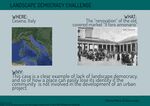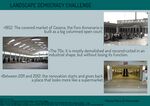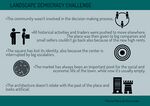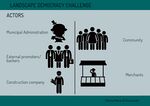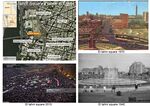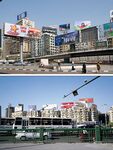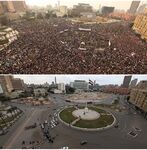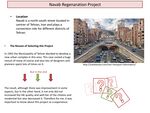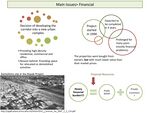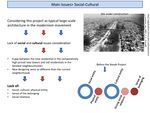LED Online Seminar 2017 - Working Group 6
--> Back to working group overview
Dear working group members. This is your group page and you will be completing the template gradually as we move through the seminar. Good luck and enjoy your collaboration!
Assignment 1 - Reading and Synthesizing Core Terminology
- You can read more details about this assignment here
- Readings are accessible via the resources page
Step 1: Your Landscape Democracy Manifestoes
Step 2: Define your readings
- Please add your readings selection for the terminology exercise before April 12:
A: Landscape and Democracy - Mapping the Terrain
- Antrop, Marc; Kühne, Olaf (2015) : Concepts of Landscape (Vittoria)
Landscape Concepts:
- Bruns/Bartolomei, 2016 'Concepts of Landscape' (Fardokht)
B: Concepts of Participation
- Arnstein, Sherry R.(1969): A Ladder of Citizen Participation, JAIP, Vol. 35, No. 4 (Vedran Vuković)
- Furco, Andrew (1996): Service-learning: A balanced approach to experiential education.(Ahmed Kamal)
C: Community and Identity
- Welk Von Mossner, Alexa (2014): Cinematic Landscapes, In: Topos, No. 88, 2014.(Ahmed Kamal)
D: Designing
- Hester, Randolph: Life, Liberty and the pursuit of Sustainable Happiness (Vittoria)
- Hester, Randolph: Democratic Drawing - Techniques for Participatory Design.(Ahmed Kamal)
E: Communicating a Vision
- 'Reading the Landscape' by Simon Bell, EMU Tartu (Vedran Vuković)
Steps 3 and 4: Concepts Selection and definition
- Each group member selects three relevant concepts derived from his/her readings and synthesize them/publish them on the wiki by April 30, 2017
- Group members reflect within their groups and define their chosen concepts into a shared definition to be posted on the wiki by May 10, 2017.
- Other group members will be able to comment on the definitions until May 20, 2017
Concepts and definitions
Fardokht Hadjisalimi:[1]
- Concept 1: Concepts of human-centered landscape
- People’s mental landscape constructs relate to (a) General knowledge, (b) Special knowledge. Since perception is culturally contextualized, landscape is a “cultural phenomenon: (a) Sensual responses to landscape, (b) The way people attach meaning and value to it (Bruns, Bartolomei, 2016). (A theoretical model is attached in the linked file)
- Concept 2: Areas that people perceive as landscape
- The landscape is people’s perception of their surroundings, a kind of nostalgia that can be detected. Our perceptions are socially and culturally contextualized, including memory. Landscape’s meanings can be interpreted by our minds and it can be perceived and appreciated differently by insiders and outsiders (Bruns, Bartolomei, 2016).
- Concept 3: Value people give to in areas of their surroundings
- According to constructive theory, we have four layers model about what people give value to in their surroundings (Bruns, Bartolomei, 2016):
1.Physical features and processes of nature and human made artifacts 2.Things that people take note of in areas of surrounding 3.Values that are shared among members of groups, learn from so called “significant others” 4.Individual landscape experience, values and emotions (A brief model and examples are attached in the shared link)
Vittoria Maria Di Giannatale:
- Concept 1: The pursuit of sustainability: the needed metamorphosis of cities.
Nowadays, there is this vicious circle where intrinsic nonsustainable habits lead to nonsustainable environments, which reinforce nonsustainable habits and so on. The dissociation modern man has from “nature” is basically caused by the accomplishment of “freedom” through technology. Being now sustainability an imperative, designers must then re-educate people to behaviours that go side by side with landscape and sustainability. The wide variety of factors that can lead to the metamorphosis of cities into sustainable ones, in fact, refers not only to the space itself but also and especially to the communities that live it. Transformation of behaviours and space goes hand in hand.(Hester, Randolph: Life, Liberty and the pursuit of Sustainable Happiness)
- Concept 2: How to accomplish the metamorphosis of cities: the community.
Communities must feel involved and connected, physically and socially. This can be helped by the creation of places where people can share experiences. For example, good resources could be sacred places and educative environments. That’s because you protect what you know and care about. The pursuit of sustainability must then involve the partecipation of the community in the decision making process, which is best to maintain on a regional or neighborhood layer. In the end, citizens must be inspired to move from short-term, selfish interests towards a wider long-term public good. Here the designer must help this transition, because the process can be slow and shocking at first impression. (Hester, Randolph: Life, Liberty and the pursuit of Sustainable Happiness)
- Concept 3: How to accomplish the metamorphosis of cities: the space and the importance of resilience.
In the sustainable refurbishment process, factors that interest more the space itself are for example the importance of physical connections, especially between natural and built environment, because a connection promotes meeting. Then, the characterisation of an area, which is best to develop without trying to innerly change it and lose in this way its identity. Last but not the least, the fundamental core is the importance of resilience. The city must be resilient in order to be sustainable, in relation with its limits and biodiversity. The land itself tells how to build more resiliently. A sustainable city must be characterized by diversity, adaptibility, must have a limited extent, for a best functioning, and work on its apparent weaknesses to make them virtues (ex. recycling). (Hester, Randolph: Life, Liberty and the pursuit of Sustainable Happiness)
Vedran Vuković:
- Concept 1: Citizen participation
- Citizen participation is a way of dividing power in order for the people/citizens to get a say in the political and economical decision making, as well as other matters of high importance to them. Citizen participation and decisions being made by the people is a base for a functioning democratic society.
- Arnstein, Sherry R.(1969): A Ladder of Citizen Participation, JAIP, Vol. 35, No. 4
- Concept 2: Participation and nonparticipation
- Aldo citizens seemingly may be participating in a decision making process that essentially might not be the case. Therefore, it is necessary to differentiate between the real citizen participation where people hold the power and the formal participation simply performed to satisfy the requirements of an existing participation process in a democratic society, as well as other stages from nonparticipatory approach to substantial citizen power.
- Arnstein, Sherry R.(1969): A Ladder of Citizen Participation, JAIP, Vol. 35, No. 4
- Concept 3: Examining the landscape
- Reading the landscape and taking under consideration all of the aspects of a landscape character is essential for proper understanding of the landscape and landscape management. Landscape cannot be described only by examining its geographical elements, but also by realizing its visual and experiential characteristics which varies from one individual person to another, and their perception of the landscape.
- 'Reading the Landscape' by Simon Bell, EMU Tartu
AHMED KAMAL:
- Concept 1: democratic drawing.
- “Drawing” is used to include the representation of the landscape by designers and community members through a broad range of media from sketching, painting and collage to modeling by hand or machine. also it used to visualize precisely places being designed. And understanding a place, communicating the detailed dimensions or essence of a space. By drawing the lines, designers imagine good space. they try to draw meaningful lines so that the space can be precious for people. This is why we need citizen participation. It is only through this process that lines have meaning and begin to live which gives meaning to people.
- Concept 2: The serving learning.
- The service learning is educational programs for students whose have international goals to learn and develop through active participation by extending student learning beyond the class room and into the community through international internships, volunteerism programs, community services and field education programs.
- .......
Step 5: Reflection
- Please write, as a group, a 250 words reflection on your discourse and document it here
Step 6: Revised manifestoes
- please look again at your initial manifestoes and update them with any new aspects/prespectives you have taken up during this seminar
- Updatedmanifesto1.jpg
xy's updated manifesto
- Updatedmanifesto2.jpg
xy's updated manifesto
- Updatedmanifesto3.jpg
xy's updated manifesto
- Updatedmanifesto4.jpg
xy's updated manifesto
- Updatedmanifesto5.jpg
xy's updated manifesto
Assignment 2 - Your Landscape Symbols
- You can read more details about this assignment here
Fardokht Hadjisalimi
The National Garden with a historical and governmental concept is located in Tehran, Iran. In the past, because of the military shooting range during the Qajar period, it was called as the Parade Square. Currently important governmental offices and museums are built in this area and lots of people go there to walk and visit the place.
- Symbol yourname photovoice4
add a caption (one paragraph max) description of the symbolism, interpretation, as well as geo-location
- Symbol yourname photovoice5
add a caption (one paragraph max) description of the symbolism, interpretation, as well as geo-location
Ahmed Kamal
- Symbol yourname photovoice4
add a caption (one paragraph max) description of the symbolism, interpretation, as well as geo-location
- Symbol yourname photovoice5
add a caption (one paragraph max) description of the symbolism, interpretation, as well as geo-location
Vedran Vuković
- Symbol yourname photovoice4
add a caption (one paragraph max) description of the symbolism, interpretation, as well as geo-location
- Symbol yourname photovoice5
add a caption (one paragraph max) description of the symbolism, interpretation, as well as geo-location
Vittoria Maria Di Giannatale
In this picture I show how we can influence everyday landscape with our own signs and symbols. This graffiti is located in Rimini, which is a town very close by the town where I study in, Cesena. It shows the symbols of Rimini and the park where it is located, a rooster and a peacock. [44°03'50.6"N 12°33'46.0"E]
This picture is unfortunately a bit blurry, but here I have photographed la Rocca Malatestiana, in the city where I study. This is my historical symbol, which belongs to the landscape of my everyday life. It dominates Cesena from above, and it's not only a symbol but also a place where people gather to spend free time. [44°08'10.7"N 12°14'23.7"E]
This is a typical landscape along the costa dei trabocchi. Costa means seashore and a trabocco is an ancient fishing “machine”. Along the shore some of these trabocchi were turned into restaurants, while some are considered as monuments. Trabocchi are an active presence of the landscape, they characterize it, shape it and create gathering and tourism. [42°17'46.6"N 14°27'58.4"E]
Rocca Calascio is characterized by the presence of a medieval castle, from which you can have one of the most striking views of the region of Abruzzo. This is an interesting example of artificial elements melting and coexisting perfectly with natural ones. Nature is dominated by the building but in a balanced way and without being obscured. [42°19'44.0"N 13°41'19.9"E]
This building is considered as an example of not democratic landscape. In an area of small houses and green areas it arises breaking every balance. Next to it you can see an historical house (it is a mill that the municipality is going to renovate) which is totally dominated by it. [44°08'28.7"N 12°14'26.4"E]
Assignment 3 - Role Play on Landscape Democracy "movers and shakers"
- You can read more details about this assignment here
Assignment 4 - Your Landscape Democracy Challenge
- You can read more details about this assignment here
- Each group member will specify a landscape democracy challenge in his/her environment
Vittoria Maria Di Giannatale
- The lost pivot
Your references:
- www.cesenatoday.it
- www.ilrestodelcarlino.it
- www.romagnanoi.it
- https://cesenaunderpaper.wordpress.com
- www.romagnaposa.it
- www.comune.cesena.fc.it
- Citizens of Cesena
ahmed kamal
- El tahrir square between past and now
caption: why did you select this case? Tahrir (liberation) Square is one of Cairo's most important squares. Originally part of the Nile river bed, the site was firstly urbanized in the 19th century and after that The square became a symbol for the ongoing Egyptian democracy demonstrations moreover it consider as a good place for people to talk about politics issue ,thinking about future and socialize . all were gathered under the same slogan of seeking a better life, which guarantees "freedom, respect and social justice" they all called "the square spirit", this is true Egyptians characteristics. British Prime Minister David Cameron, Catherine Ashton, , Hillary Clintons and others visited el Tahrir square .
caption: what is the issue/conflict.? Billboards above the buildings surrounding the square, where it's the most expensive spot in Cairo. But the problem here is that these advertisements became more dominant then the buildings where the buildings are one of the most obvious features around the square because of their unique Architecture. So do el Tahrir's Users perceive the building or the billboard?
Your references:
- www.isocarp.net
- www.cairomsc.blogspot.de
- www.bbc.com
Vedran Vuković
- Savica, there and back again
caption: The location of the challenge is set in my hometown, the city of Zagreb, in Croatia. The problem is a reoccuring effort in the last five years to change a green area/park into something that would be against the will of the population livin in that area, without consulting or informing them first.
Your references:
- http://www.vijesti.rtl.hr/video/vijesti/162245/sprajc-na-samo-sebi-svojstven-nacin-objasnio-tko-i-zasto-ratuje-na-savici/
- http://hr.n1info.com/a194054/Vijesti/Za-uredjenje-parka-na-Savici-700-stanovnika-103-protiv.html
- https://www.vecernji.hr/zagreb/prosvjed-protiv-gradnje-crkve-u-parku-na-savici-1097433
- https://dalicom.eu/tko-to-tamo-rusinemam-nista-protiv-crkve-ali-mi-je-draze-da-se-moja-djeca-mogu-igrati-u-zelenilu/?print=print
- http://dnevnik.hr/vijesti/hrvatska/milan-bandic-na-savici-gradi-park-stanovnici-najavili-prosvjed---473877.html
Fardokht Hadjisalimi
- Give a title to your challenge
Your references:
- http://irandoostan.com/iran-transport-information/
- http://applications.emro.who.int/imemrf/int_j_environ_res_2007_1_2_114.pdf
- Bahrainy, Aminzadeh, 2006, Avaluation of Navab Regeneration Project in Central Tehran, Iran
Assignment 5 - Your Democratic Change Process
- You can read more details about this assignment here
- After documenting and reflecting on your challenges you will continue jointly with one of these challenges and design a democratic change process
Your Democratic Change Process
- Add the title of your project
- Yourgroupname 2017 powermap.jpg
a power map identifying who is affected by the challenge and who is influencing it
- Yourgroupname 2017 change process (1).jpg
Look at the various methods and tools available and think how they can be applied creatively. Think about the needs of different stakeholder groups - you may need a methodical mix to address them all. Illustrate graphically how these methods/tools might be applied in a short, medium and long-term perspective.
- Yourgroupname 2017 scenario.jpg
a scenario illustrating how these tools can be applied within a short, medium and long term perspective involving the groups you want to address, this should include a process timeline
Reflection
- Evaluate in the group how far your ideas either built on the theoretical frame that has been introduced to you during this seminar or react to this by filling a potential gap (approx 150 words)
Your references
- ....
- ....
- ....
- ....




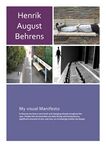
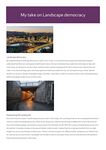
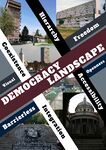





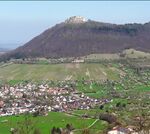
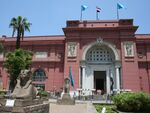


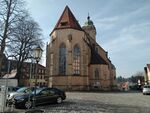
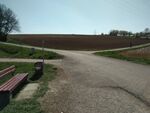
![In this picture you can see the Gran Sasso mountain, right from the window of my house in my hometown Villa Vomano, Abruzzo. This is my example of a strong, powerfull natural landscape symbol, which dominates and characterizes our everyday view. [42°37'04.7"N 13°46'34.6"E]](/images/thumb/0/02/LandscapeSymbol1.jpg/150px-LandscapeSymbol1.jpg)
![In this picture I show how we can influence everyday landscape with our own signs and symbols. This graffiti is located in Rimini, which is a town very close by the town where I study in, Cesena. It shows the symbols of Rimini and the park where it is located, a rooster and a peacock. [44°03'50.6"N 12°33'46.0"E]](/images/thumb/5/53/LandscapeSymbol2.jpg/150px-LandscapeSymbol2.jpg)
![This picture is unfortunately a bit blurry, but here I have photographed la Rocca Malatestiana, in the city where I study. This is my historical symbol, which belongs to the landscape of my everyday life. It dominates Cesena from above, and it's not only a symbol but also a place where people gather to spend free time. [44°08'10.7"N 12°14'23.7"E]](/images/thumb/c/c4/LandscapeSymbol3.jpg/112px-LandscapeSymbol3.jpg)
![This is a typical landscape along the costa dei trabocchi. Costa means seashore and a trabocco is an ancient fishing “machine”. Along the shore some of these trabocchi were turned into restaurants, while some are considered as monuments. Trabocchi are an active presence of the landscape, they characterize it, shape it and create gathering and tourism. [42°17'46.6"N 14°27'58.4"E]](/images/thumb/5/5b/Landscapesymbol4.jpg/150px-Landscapesymbol4.jpg)
![Rocca Calascio is characterized by the presence of a medieval castle, from which you can have one of the most striking views of the region of Abruzzo. This is an interesting example of artificial elements melting and coexisting perfectly with natural ones. Nature is dominated by the building but in a balanced way and without being obscured. [42°19'44.0"N 13°41'19.9"E]](/images/thumb/7/74/Landscapesymbol5.jpg/150px-Landscapesymbol5.jpg)
![This building is considered as an example of not democratic landscape. In an area of small houses and green areas it arises breaking every balance. Next to it you can see an historical house (it is a mill that the municipality is going to renovate) which is totally dominated by it. [44°08'28.7"N 12°14'26.4"E]](/images/thumb/9/9b/Landscapesymbol6.jpg/150px-Landscapesymbol6.jpg)
